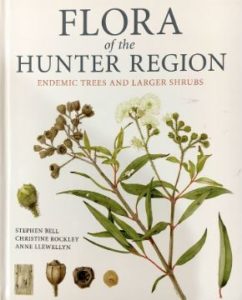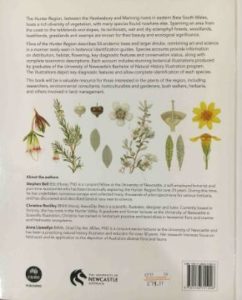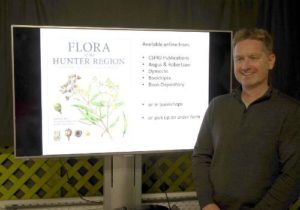The following review by Andrew Pengelly first appeared in Gumleaves June 2019, the newsletter of APS Hunter Valley Group and is reproduced with permission.

Flora of the Hunter Region by Stephen Bell, Christine Rockley and Anne Llewellyn
This is a remarkable publication, given that it provides detailed and authoritative botanical monographs of 54 trees and shrubs that are endemic to the Hunter region, each one of which is accompanied by a full-page scientific illustration.
The lead author, Dr Stephen Bell, is probably the leading botanist in the region, having undertaken countless plant surveys over the last 25 years.
The fact that the other two co-authors, Christine Rockley and Dr Anne Llewellyn, are both scientific illustrators, demonstrates the significance placed on the illustration component of this book. In fact as many as 20 different illustrators were used, all alumni of the Bachelor of Natural History program at the University of Newcastle.
Each monograph contains the full nomenclature and etymology (origin of the botanical name), distribution (with map) and known reservation plus location of the “type” specimen, habitat including a long list of species it occurs with, flowering period, affinities with similar species and hints on differentiating them, key diagnostic features, conservation status, plus a protologue ie the original material associated with a newly published name, comprising detailed botanical descriptions.
 Potential health promoting species of interest are the Pokolbin mallee (Eucalyptus pumila), the North Rothbury Persoonia (Persoonia pauciflora) and the broad-leaved pepperbush (Tasmannia purpurascens). There are some entries for species of interest from the point of view of their essential oil potential, but given that many of them are threatened or of limited distribution, they aren’t readily available for distillation. One such species is Prostanthera cineolifera, so named by Baker and Smith (pioneers of essential oil analysis of Australian plants) because it contains 1,8-cineole, giving off a eucalyptus-like fragrance. This species grows in a limited range centred around the Brokenback Range.
Potential health promoting species of interest are the Pokolbin mallee (Eucalyptus pumila), the North Rothbury Persoonia (Persoonia pauciflora) and the broad-leaved pepperbush (Tasmannia purpurascens). There are some entries for species of interest from the point of view of their essential oil potential, but given that many of them are threatened or of limited distribution, they aren’t readily available for distillation. One such species is Prostanthera cineolifera, so named by Baker and Smith (pioneers of essential oil analysis of Australian plants) because it contains 1,8-cineole, giving off a eucalyptus-like fragrance. This species grows in a limited range centred around the Brokenback Range.
Additional information provided includes a glossary, an ecological and taxonomic bibliography, specimen collection locations plus coordinates (latitude/longitude) for locations mentioned and conservation assessments for each species.
Back cover of Flora of Hunter Region

The full title is Flora of the Hunter Region. Endemic Trees and Larger Shrubs, published by CSIRO Clayton Vic, 2019. A second volume is in preparation, which will include herbs, grasses, orchids and other smaller plants. The recommended retail is A$80, however it has apparently already sold out, so we wait for the next printing.
This book is a must for native plant enthusiasts in the Hunter region, and for people anywhere who enjoy botanical artistry.
Dr Andrew Bell at APS NSW Newcastle get together, 17 August 2019 (photo Kevin Stokes)
